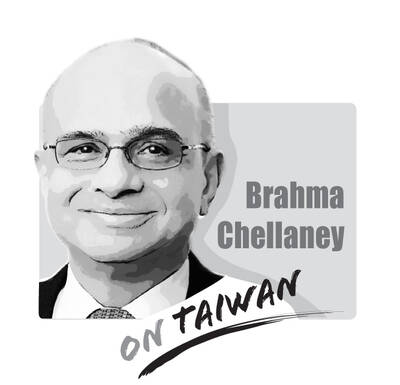Wonderful Copenhagen
Having lived in Copenhagen before coming to Taiwan, I want to add to a recent article with suggestions on how to make cycling more attractive in Taiwan’s cities (“Copenhagen’s cycle paths become highways,” Nov. 30, page 6).
There have been efforts to increase the number of cyclists in Taiwan, but they have often not been very successful because they have lacked the comprehensive and systematic approach that Copenhagen has taken (“Lane a testament to incompetence,” March 26, page 8).
The three essentials that are crucial for any strategy to get people out of cars and onto bicycles are: Cycling has to be comfortable and safe; it has to be supported by a parking and repair infrastructure; and it needs to be part of a wider push for increased public transport.
To make cycling comfortable and safe it is essential that a significant amount of space is given to raised cycle paths that cannot be used by cars or scooters. Car and scooter use, meanwhile, will only decrease with more investments into affordable public transport that reaches all parts of the city at all times of the day.
Copenhagen also reduced car lanes and parking spaces, which is one of the most effective ways of pushing cars out of cities.
Second, there needs to be a sufficient number of safe parking spaces for bicycles everywhere. It is also essential to have repair shops and pit stops that tend to bicycle upkeep and the cyclists’ comfort.
Finally, these bicycle-specific measures have to be part and parcel of a comprehensive public transport strategy because most potential cyclists, myself included, will not switch to using bicycles unless the danger and pollution from private cars and scooters is significantly reduced, which includes ensuring that car drivers respect traffic laws, that public transport replaces most private means of transportation and that the remaining private traffic becomes electric.
All these things are ongoing in Copenhagen, where, as a cyclist, I never felt bothered by pollution and I always felt safe, as I knew that car drivers took care simply because they were used to the presence of cyclists.
By contrast, I rarely ever cycle in Taipei because it is just too uncomfortable and dangerous. This is a shame because I really miss the exercise and the freedom and speed of movement it afforded me in Copenhagen.
Copenhagen is achieving systematic change, where a car-dominated system is now being replaced by a public-transport system. The most important lesson is that all elements have to be implemented together because people will not make the switch to public transport as long as cars and scooters achieve the primary goal — getting from A to B — more effectively than the public transport alternatives.
Once public transport achieves this primary objective more cheaply, efficiently and safely, people will happily make the switch in large numbers, with great benefits to the urban environment, public health, and energy efficiency.
Piecemeal solutions will not be successful — see the Dunhua cycle lane disaster — but comprehensive, smart solutions will — note the case of Copenhagen.
Bruno Walther
Taipei

Taiwan stands at the epicenter of a seismic shift that will determine the Indo-Pacific’s future security architecture. Whether deterrence prevails or collapses will reverberate far beyond the Taiwan Strait, fundamentally reshaping global power dynamics. The stakes could not be higher. Today, Taipei confronts an unprecedented convergence of threats from an increasingly muscular China that has intensified its multidimensional pressure campaign. Beijing’s strategy is comprehensive: military intimidation, diplomatic isolation, economic coercion, and sophisticated influence operations designed to fracture Taiwan’s democratic society from within. This challenge is magnified by Taiwan’s internal political divisions, which extend to fundamental questions about the island’s identity and future
The narrative surrounding Indian Prime Minister Narendra Modi’s attendance at last week’s Shanghai Cooperation Organization (SCO) summit — where he held hands with Russian President Vladimir Putin and chatted amiably with Chinese President Xi Jinping (習近平) — was widely framed as a signal of Modi distancing himself from the US and edging closer to regional autocrats. It was depicted as Modi reacting to the levying of high US tariffs, burying the hatchet over border disputes with China, and heralding less engagement with the Quadrilateral Security dialogue (Quad) composed of the US, India, Japan and Australia. With Modi in China for the
The Chinese Nationalist Party (KMT) has postponed its chairperson candidate registration for two weeks, and so far, nine people have announced their intention to run for chairperson, the most on record, with more expected to announce their campaign in the final days. On the evening of Aug. 23, shortly after seven KMT lawmakers survived recall votes, KMT Chairman Eric Chu (朱立倫) announced he would step down and urged Taichung Mayor Lu Shiow-yen (盧秀燕) to step in and lead the party back to power. Lu immediately ruled herself out the following day, leaving the subject in question. In the days that followed, several
The Jamestown Foundation last week published an article exposing Beijing’s oil rigs and other potential dual-use platforms in waters near Pratas Island (Dongsha Island, 東沙島). China’s activities there resembled what they did in the East China Sea, inside the exclusive economic zones of Japan and South Korea, as well as with other South China Sea claimants. However, the most surprising element of the report was that the authors’ government contacts and Jamestown’s own evinced little awareness of China’s activities. That Beijing’s testing of Taiwanese (and its allies) situational awareness seemingly went unnoticed strongly suggests the need for more intelligence. Taiwan’s naval